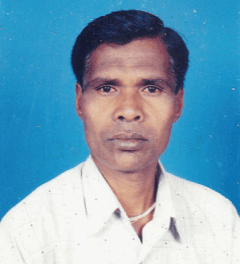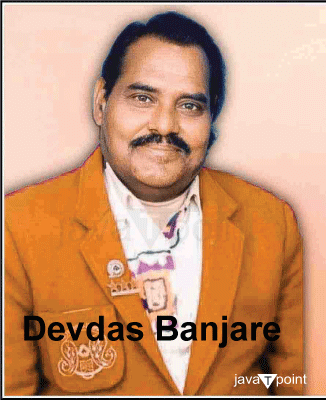Devdas Banjare
IntroductionDevdas Banjare was born on January 1, 1937, in Sakra Village in Chhattisgarh's Dhamtari District. His father's name is Phool Singh Banjare. Banjare used to play kabaddi as a kid and is well-known for his panthi dance performances. Panthi dance is popular in Chhattisgarh and has spread throughout the world. Devdas Banjara is solely responsible for the global fame of the Panthi dance. Devdas Banjare represented India in various dance festivals. In 1975 and 1972, he received the President's and Chief Minister's Gold Medals. Why Did Banjare Stop Playing Kabaddi?Banjare was encouraged to pursue his interest by the Bhilai Steel Plant (BSP), where he worked as an instructor of dance in the education department. Over two decades, Banjara gained the BSP tremendous renown and respect. The Satnami community of Chhattisgarh is the originator of the Panthi dance form. Guru Ghasidasji is revered as the Satnamis' Guru. Panthi dance is one of the ways they honor their Teacher. "It is the primary duty of individuals to safeguard their physical well-being and health so that they can properly use what God has given them to do good deeds and execute what they have to do correctly," Banjare said in an interview. What is the most critical responsibility of any person, according to Banjare? The dancers in Panthi perform numerous Mudras that include 'Jai Sthamb,' 'Dharti Pranam' (invocation to the land), and 'Phool Arpan' (flower giving). The Satnami community's rich culture and legacy are exhibited through traditional costumes and, more significantly, the spirit of the dancers. The dancer's outfit comprises the 'Ghungroo,' 'Dhoti & Kurta,' and 'Kanthi' (Tulsi garland). The artists are accompanied in their performance by indigenous instruments like the 'Mandar' (Dhol). Panthi DancePanthi dance represents one of the most prominent dance genres in the Indian state of Chhattisgarh. This ancient Indian dance has become a popular custom in Chhattisgarh's Satnami community. The dance is performed extremely vocally and is complemented by lovely melodies. The dance shows the rich cultural & artistic heritage of the region's indigenous communities. It is interwoven with religion and reflects the state's various dancing forms. The Durg region has been considered the most significant in Chattisgarh's history. Since ancient times, it has served as one of the most important settlements. Panthi performs a variety of dances to demonstrate the significance of the Durg region to its people. Maghi Purnima, the birth anniversary of Guru Baba Ghasidas, was performed. The dance moves through many stages and rhythms. History of Panthi DanceIn Chhattisgarh, Panthi is a Satnami clan dance. Satnami serves as one of the region's regional settlements. Dancing is a natural form of devotion with religious overtones. Satanists believe in Nirvana ideology, and their dance expresses that. The Panti dance was performed at the Maghi Purnima celebration of Satnami Master Ghasi Das' birthday. Panthi dance, one of Satnami's favorite old tales, is performed with tremendous zeal by the people. Dance differs in its musical instruments, rhythm, and atmosphere, updated by the empire's state. Panti dancers dress up in vibrant traditional attire. They also wear little jewels to match their outfits. The outfit shows the robust and adaptable lifestyles of the people of Chhattisgarh. Performance of Panthi DanceMale dancers are the only ones who perform. Dancers perform around the Jaitkhamb set up for the event, chanting songs honoring their spiritual leader. The songs also reflect Nirvana philosophy, which communicates the spirit of leaving their Guru and the lessons of sacred writers like Kabir, Guru Ramdas Ji, Dadu, and others. This dance needs a lot of flexibility and endurance because it incorporates a lot of complicated steps. Work starts with a gentle body movement. The group leader performs a song, and the others sing a brief song in response. Dancers with curving bodies and flying arms continue to perform until their commitment is revoked. They perform acrobatics and even build human towers as the pace picks up. Persons or followers of the Panthi Nritya Mandir mainly perform this dance. Dancers move to the beats of indigenous instruments such as the Mridanga and Jhaanj. The dancers occasionally dance to the loud tempo of the drums. Famous Panthi Dancer: Devdas BanjareDevdas Banjara is the primary figure in the Panthi dance. Devdas Banjara established his heritage and has shown the world the tradition of this dance. Devdas created a band and traveled the world dancing without professional dance training. He received the Guru Ghasi Das Trophy for contributing to the Dalit community's progress. In addition, he received the Presidential Award for his team's outstanding performances in traditional dancing. Her dancers dressed in traditional Ghungroo and Kurta and wowed the audience with their breathtaking performances. It represents Chhattisgarh's rich tribal heritage. 
According to Banjare, what is the most critical responsibility of any person?The dancers in Panthi perform numerous Mudras such as 'Jai Sthamb,' 'Dharti Pranam' (invocation to the land), and 'Phool Arpan' (flower giving). The Satnami community's rich culture and legacy are exhibited through traditional costumes and, more significantly, the spirit of the dancers. The dancer's outfit comprises the 'Ghungroo,' 'Dhoti & Kurta,' and 'Kanthi' (Tulsi garland). The artists are accompanied in their performance by indigenous instruments like the 'Mandar' (Dhol). The performer previously performed with Habib Tanvir's Modern Theatre and had visited various nations. His performance in Shyam Benegal's film 'Charandas Chor' got critical appreciation. Banjare had often appeared as a folk art representation of India during the Bharat Utsav festivities. In his 30-year career, he has visited over 60 nations. He was awarded the Chief Minister's gold medal in 1972, the President's gold medal in 1975, and numerous additional honors. Devdas Banjare's DeathDevdas Banjare was killed in an automobile accident in 2005. His legacy, however, lives on as several of his pupils keep on stage Panthi performances throughout the country and overseas. Banjare's dedication to Panthi was unrivaled, and he committed his life to popularizing his community's and state's rich traditions and customs. Prasanthi News, events at Prasanthi Nilayam during June 21st to June 23rd, 2005. During this time, the activities ranged across a pulsating tribal dance performance by worshippers from Chhatisgarh to a nectareous divine. The programme featured tribal dances performed by the Satnami tribe, who live in the centre of Chhatisgarh. Devdas Banjare, a dance master from the village of Dhanora, some 13 km from Bhilai, has become an internationally acclaimed performer who has received the President's Award and has travelled to over 64 countries. As a Bhagawan devotee, his deep ambition was to serve in the Divine Presence. The dance was rigorous and energetic, with the dancers themselves playing loud sounds from drums and cymbals. All of the dance positions reflected modes of homage for the saint, Sant Ghasi Das. Panthi Nritya is the name given to this dance form. The dance lasted approximately twenty minutes and featured a variety of patterns, pyramids, and other structures. The dancers exited the stage to thunderous ovation at 3:50 p.m. ConclusionDevdas Banjare was born in Sakra Village, Dhamtari District, on January 1, 1937. His dad's name was Bodhram, but he was raised by Phool Singh Banjare, whose last name he assumed. Also he was by chance introduced to Panthi dance. Banjare was a talented Kabaddi player when he was younger. Devdas Banjare represented India in various dance festivals. In 1975 and 1972, he received the Gold Medal from the President and Chief Minister.
Next TopicDivya Tanwar
|
 For Videos Join Our Youtube Channel: Join Now
For Videos Join Our Youtube Channel: Join Now
Feedback
- Send your Feedback to [email protected]
Help Others, Please Share









